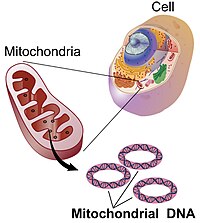
Photo from wikipedia
Plant mitochondrial genomes are usually assembled and displayed as circular maps based on the widely-held view across the broad community of life scientists that circular genome-sized molecules are the primary… Click to show full abstract
Plant mitochondrial genomes are usually assembled and displayed as circular maps based on the widely-held view across the broad community of life scientists that circular genome-sized molecules are the primary form of plant mitochondrial DNA, despite the understanding by plant mitochondrial researchers that this is an inaccurate and outdated concept. Many plant mitochondrial genomes have one or more pairs of large repeats that can act as sites for inter- or intramolecular recombination, leading to multiple alternative arrangements (isoforms). Most mitochondrial genomes have been assembled using methods unable to capture the complete spectrum of isoforms within a species, leading to an incomplete inference of their structure and recombinational activity. To document and investigate underlying reasons for structural diversity in plant mitochondrial DNA, we used long-read (PacBio) and short-read (Illumina) sequencing data to assemble and compare mitochondrial genomes of domesticated (Lactuca sativa) and wild (L. saligna and L. serriola) lettuce species. We characterized a comprehensive, complex set of isoforms within each species and compared genome structures between species. Physical analysis of L. sativa mtDNA molecules by fluorescence microscopy revealed a variety of linear, branched, and circular structures. The mitochondrial genomes for L. sativa and L. serriola were identical in sequence and arrangement and differed substantially from L. saligna, indicating that the mitochondrial genome structure did not change during domestication. From the isoforms in our data, we infer that recombination occurs at repeats of all sizes at variable frequencies. The differences in genome structure between L. saligna and the two other Lactuca species can be largely explained by rare recombination events that rearranged the structure. Our data demonstrate that representations of plant mitochondrial genomes as simple, circular molecules are not accurate descriptions of their true nature and that in reality plant mitochondrial DNA is a complex, dynamic mixture of forms.
Journal Title: PLoS Genetics
Year Published: 2019
Link to full text (if available)
Share on Social Media: Sign Up to like & get
recommendations!